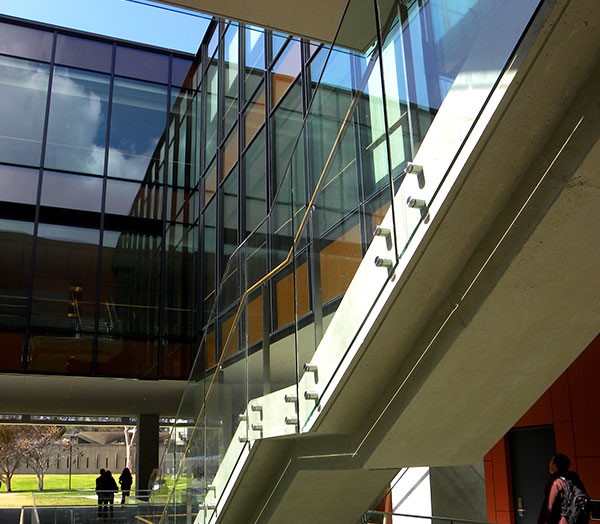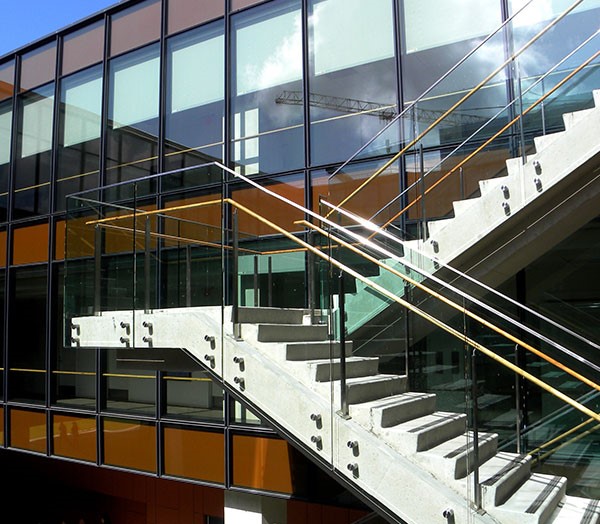Earn LEED Certification with HDI
Published 05/26/16When designing a large-scale commercial project, an architect’s choices make a clear statement about the character of their client.
For instance, an architect’s subtle aesthetics can express a distinct personality—modern or classic. Furthermore, choosing ecologically sustainable materials and construction processes makes a statement about the importance of environmental sustainability.
HDI takes steps to facilitate a “green” project, both in regards to our processes and our materials. In fact, installation of HDI railings systems often earns highly-sought-after Leadership in Energy and Environmental Design (LEED) credits.
LEED accreditation and a partnership with HDI contributes environmental stewardship and a world-class railing system to your construction project.

HDI partnered with the University of California San Diego School of Medicine to provide the Optik Boss railing system. The project earned LEED Gold Certification.
LEED Credits and Certifications
The LEED Certificate system recognizes builders for using environmentally-beneficial practices and materials in construction. Following construction, all credits are tallied and a certification is granted. Levels include: Certified, Silver, Gold, and Platinum.
Organized by the United States Green Building Council (USGBC), the LEED program ranks as the most respected benchmark for grading environmentally-sound construction projects.
The USGBC encourages companies to advertise their LEED certification.
A new focus on green construction
In the 21st century, recognition for environmental stewardship, more than ever, is a boon for a business’s image. Simultaneously, developments in green construction make sustainable practices more convenient than ever.
The prominence of the LEED accreditation demonstrates that more businesses seek to be recognized as environmental leaders and that doing so is convenient. Architects and companies work hard to earn the widely recognized USGBC and LEED accreditation.

HDI partnered with the University of California San Diego School of Medicine to provide the Optik Boss railing system. The project earned LEED Gold Certification.
How are LEED Credits Earned?
LEED credits can be earned in a variety of ways — from including on-site bicycle access to incorporating an energy-saving design.
View the full library of LEED credits
HDI Partnership
In our daily operation, HDI strives to manage natural resources effectively, conserve energy wherever possible, and minimize material waste in the production phase of our railing systems.
Environmental responsibility is in our company’s DNA, and it also represents a valuable service to offer to our partners.
For projects located within 500 miles of our factory, partnering with HDI may earn LEED credit.
Whenever possible, we source each railing system component in an environmentally-conscious way. As a result, several different aspects of a HDI railing system can earn LEED accreditation.
Steel
Created by melting down scrap alloy at 3,000+ degree temperatures, stainless steel stands as the most recycled material in the world.
The primary material component in HDI railing systems, our AISI 304 or 316 stainless steel is composed of 45% to 65% recycled material. The use of recycled material is a hallmark method of earning LEED credits.
Due to their corrosion resistance and secure construction, our steel railing systems last a minimum of 30 years without replacement, earning LEED credits for longevity.
Powder Coating
More resilient than paint or traditional finish, the powder coating applied to the steel handrails is also a superior, environmentally safe option.
Our powder coating formula does not contain solvents, meaning its application does not harm groundwater, soil, or air.
The USGBC awards LEED credits for limiting the use of harmful chemicals in construction.
LEDs
HDI railing systems can be equipped with LED lights, providing a distinct aesthetic touch and added visibility at night.
The use of LEDs is an environmentally-friendly choice compared to other incandescent light sources. LEDs are more energy efficient and do not contain the harmful metal mercury, which is found in compact fluorescent bulbs.
Depending on the specifics of your design, including LEDs in your handrail system can earn several LEED credits in multiple categories.
Wood
Using natural wood as a handrail material uniquely complements some indoor railings systems, based on decor.
While irresponsible logging leads to deforestation and the destruction of habitats, wood can be an environmentally friendly material. The source of the lumber entirely determines whether wood is an environmentally-sustainable choice.
For our wood handrails, HDI only utilizes wood harvested from certified forests.
Conclusion
Each multifaceted construction project conveys the personality of the architect designing it and the business it will represent. Earning LEED certification for your construction project makes the statement that your organization is forward thinking, by taking a stewardship role toward the planet.
This is where HDI can help. As always, we will provide the ideal railing system for your space and we can do so while employing environmentally responsible methods.
Contact HDI for a conversation about your next construction project.
